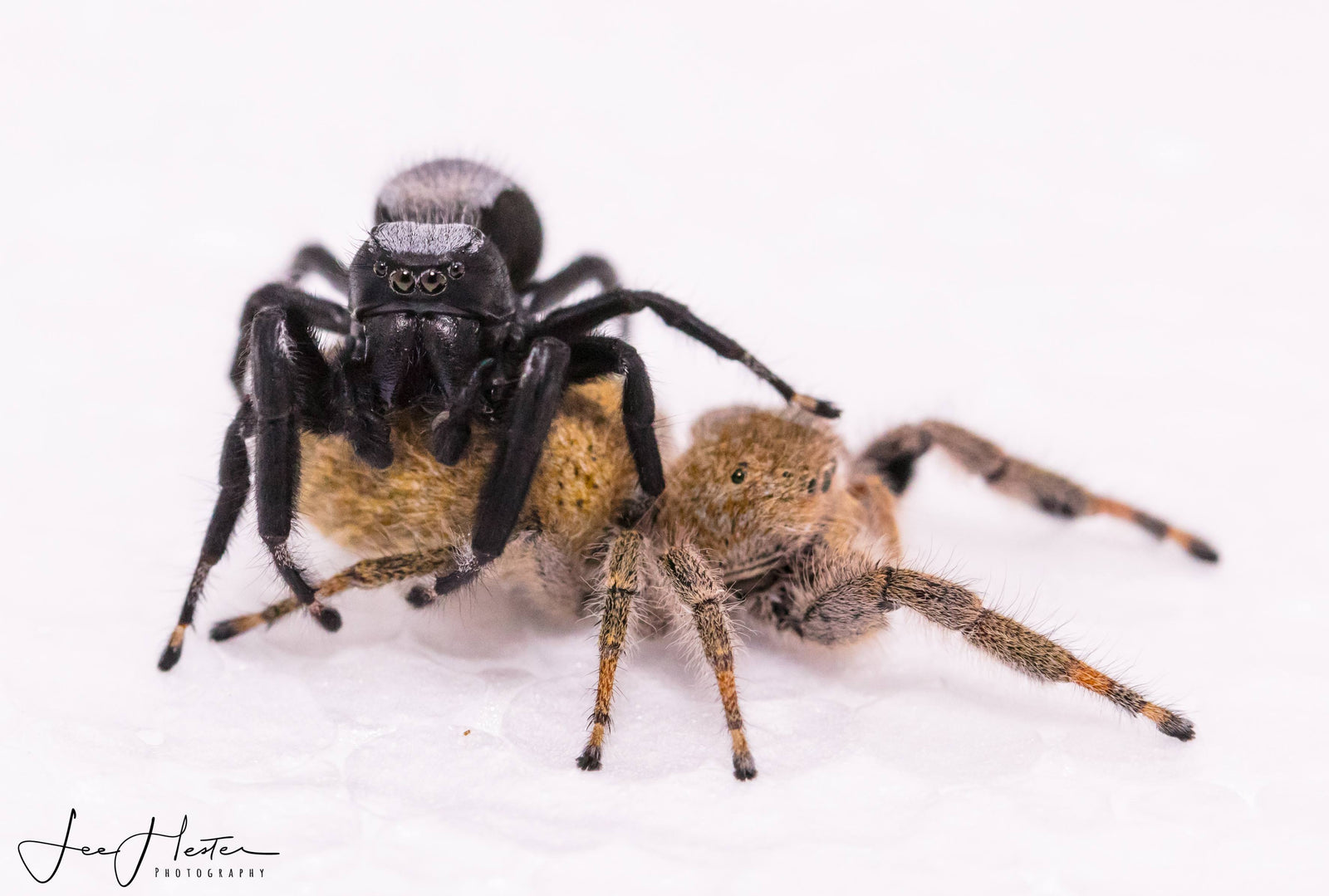|
Kingdom |
Anamalia |
|
Phylum |
Arthropod |
|
Subphylum |
Chelicerata |
|
Class |
Arachnida |
|
Order |
Araneae |
|
Infraorder |
Araneomorphae |
|
Family |
Salticidae |
|
Genus |
Phidippus |
|
Species |
octopunctatus |
As promised earlier this week, today’s Salticidae Sunday will focus on the P. octopunctatus. We have nicknamed these sassy little creatures the octopunk, and they are truly an interesting species of jumping spider. Also, their mating dance was the funniest I have seen. More on that later though.
Identification
The octopunk is one of the largest jumping spiders in North America and can get up to 25 mm in length which makes them larger than the regal. Of course, it’s only by a few mm, but still. I fell in love with the octopunk when I saw the black and grey coloring of the male. It was so different than others I had seen at the time and I became enchanted. Perhaps because black on grey combo is my favorite coloring for clothes, perhaps because the solid grey on their back was a perfect contrast to their black sides... who knows.
I was surprised to see that the females are so different in coloring. The females are brown and fuzzy with stripes on their back. You can see the color contrast in the picture below. Males resemble the female coloring until their final molt.

It always surprises me to see how different spiders look with each molt.
Personalities
Ok, I have seen fast spiders before, but these guys are FAST! One of our males ends up escaping every time we feed him. Yes, we prepare for him to run, but he still zips right past us and it takes two of us to catch him again. Several sources have noted their territorial behavior, including one post from 2006 saying a female gave her the first phid bite she has ever had. It’s not surprising though, they have been observed taking down bees and grasshoppers.
We have noticed the females tend to be a little sassier than the males. Two of our females are territorial and make it well known when we are not welcome in their personal space. I can totally relate though, when someone invades my space and I don’t want company, I have been known to be a bit sassy myself.
Please know that each spider has their own personalities, not all of them are territorial and we are still able to handle them. We know to keep our distance when they indicate they are not impressed with us and they want to be left alone. If you decide to keep these guys as pets, just learn their cues and respect their boundaries. This is true for any species, not just spiders.
These guys are also fairly new to BFP, and we are anxiously awaiting their babies so we can learn more about them. They have such a unique personality I can only imagine what it will be like to see the slings. I may update this post later once they hatch.
Also, have I mentioned how funny their mating dance was? Considering how high energy they are, I was expecting something very different.
Check out our YouTube video to watch their session.
I imagine their conversation was something like this.
“Hey, watcha doin?”
“Not much, just chillin.”
“Cool.”
“Yep.”
“So..... wanna make babies?”
“Sure, why not.”
Location and Habitat
The octopunk is typically found in desert environments like Mexico or the Great Basin Desert. Yes, they are native to Utah. If you were to look for them in the wild, you will likely find them in sagebrush. Their nests are different than other jumpers I have noticed. Both males and females make nests that spread across a large area. You can see in this picture that their nest is pretty big.

Individual Care
There isn’t much information about these guys, but generally their native location can tell you a lot about their care. Since they are located in deserts, they don’t require as much humidity as other species. Still, all things require some water, so we check and mist them every 1-2 days. I have also noticed they have ravenous appetites. We make sure to feed the adults regularly, and give them plenty of food. They are pretty hearty and ours have not been picky about food. We have fed them wax worms, crickets, and curly wing flies. Unlike some other phids, they don’t mind a hard-bodied insect like dubias.
Of course, clean out the dead food when they are finished eating and keep them in a well-ventilated enclosure.
Stay tuned to our page to see the slings when they emerge from their nest.
References:
https://en.wikipedia.org/wiki/Phidippus_octopunctatus
https://bugguide.net/node/view/74960
http://bugeric.blogspot.com/2013/01/spider-sunday-phidippus-octopunctatus.html
http://salticidae.org/salticid/diagnost/phidippu/octopunc.htm










5 comments
I just found a mail and so far your side is the only one that can give me any real information about it so I haven’t seen a female and it was running across the floor in my garage it scared the crap out of me it was that big
I love reading your blogs, I learn so much from them. I knew nothing about the octopunks before i read this, the mating dance was super funny btw. Thank you! I can’t wait for next week’s blog ♥
Thank you for the great information! i have a few Octopunks and am looking forward to more!
Great informative post! I really didn’t know much about these little octoounks before!
i love reading the weekly blogs! this is great for beginners like myself to really dive into the species that im getting and decide which one i want next! great info and pictures and its an nice clear easy read! cant wait for next weeks!